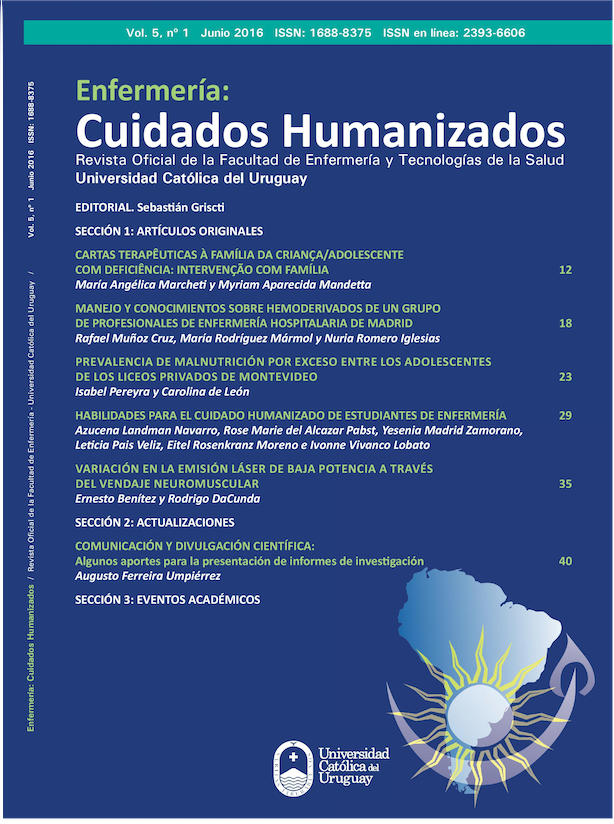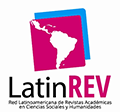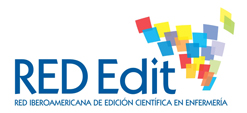PREVALENCE OF OVERWEIGHT AMONG ADOLESCENTS OF PRIVATE HIGH SCHOOLS OF MONTEVIDEO
DOI:
https://doi.org/10.22235/ech.v5i1.1189Keywords:
adolescents, nutrition, obesity, overweight, education, primary and secondary.Abstract
The World Health Organization has identified overweight and obesity as the fifth risk factor for health on a global scale. The aim of this study was to evaluate the prevalence of overweight and obesity among adolescents in high school from grade 1 to grade 4 of some private schools in Montevideo. The research assessed the nutritional status by measuring weight and height with calibrated instruments. It was found that 63% of the adolescents
are classified as having normal weight, 37% presented malnutrition by excess and 0.4% were severely underweight. Obesity was higher in males, 13.7 % against 4.7 % of the women, a statistically significant difference (p=0.001). There was also a statistically significant association between the degree course and the nutritional status (p=0,003). The population of teenagers of grade 1 presented a prevalence of obesity (16.7%) that duplicates that of grade 4 (8.5%) and is three times larger than that of grade 2 (5.2%) and grade 3 (5.0%). We found a high prevalence of overweight and obesity among adolescents in private high schools of Montevideo. When the expectation for a well-nourished population is that 82% will present a normal nutritional status (BMI/age between -2 to +1) in the present study only 63% were in this situation.
Downloads
References
Popkin BM, Gordon-Larsen P. The nutrition transition: worldwide obesity dynamics and their determinants. Int J Obes Relat Metab Disord 2004; 28 Suppl 3: S2-9.
WHO. Global health risks: mortality and burden of disease attributable to selected major risks. Genf: WHO; 2009.
WHO. Obesity: preventing and managing the global epidemic.
Report of a WHO Consultation. WHO Technical Report Series No. 894. Genf: WHO; 2000.
Calle EE, Thun MJ, Petrelli JM, Rodriguez C, Heath CW. Body mass index and mortality in a prospective cohort of US adults. N Engl J Med 1999; 341: 1097-105.
Martínez JA, Moreno B, Martínez-González MA. Prevalence of
obesity in Spain. Obes Rev 2004; 5: 171-2.
Flegal KM, Carroll MD, Ogden CL, Johnson CL. Prevalence and trends in obesity among US adults, 1999-2000. JAMA 2002; 288 (14): 1723-7.
Uauy R, Albala C, Kain J. Obesity trends in Latin America: transiting from under-to overweight. J Nutr 2001; 131:893-9.
Pisabarro R y cols. Segunda Encuesta Nacional de Sobrepeso y Obesidad (ENSO 2) adultos (18-65 años o más). Rev Med Urug 2009; 25: 14-26.
Ministerio de Salud Pública. Dirección General de la Salud. División Epidemiología. 1ª Encuesta Nacional de Factores de Riesgo de Enfermedades Crónicas No Transmisibles. Montevideo, 2009; 29-30.
Ministerio de Salud Pública. Uruguay. 2a Encuesta Nacional de Factores de Riesgo de Enfermedades Crónicas No Transmisibles. 2013. [Internet]. [citado Jul 2015]. Disponible en: http://www.msp.gub.uy/noticia/segundaencuesta-nacional-de-factores-de-riesgo-de-enfermedades-cr%C3%B3nicas-no-transmisibles.
MSP. MIDES. JND. OPS. Segunda Encuesta Nacional de Salud Adolescente. Uruguay. 2012. [Internet]. [citado Jul 2015]. Disponible en www.msp.gub.uy/publicacion/adolescencias-un-mundo-de-preguntas-ii-encuestamundial-de-salud-adolescente-gshs-2012.
Baker JL, Olsen LW, Sorensen TI. Childhood body-mass index and the risk of coronary heart disease in adulthood. New Engl J Med. 2007; 357: 2329-37.
Organización Mundial de la Salud. Departamento de Nutrición para la Salud y el Desarrollo. Patrones de Crecimiento del Niño la OMS: Curso de Capacitación sobre la evaluación del crecimiento del niño. Washington: OMS, 2008.
MSP, MIDES, RUANDI, UNICEF. Bove I, et al. Encuesta Nacional sobre estado nutricional, prácticas de alimentación y anemia en niños menores de dos años. 2011. [Internet]. [citado Ago 2015]. Disponible en: http://www.unicef.org/uruguay/spanish/encuesta_lactancia_
uruguay2011_web.pdf.
Pastén A, Peñalillo T, Navarro J. Diagnóstico nutricional de población escolar en una isla de la VIII región. Rev Chil Pediatr 2014; 85 (2): 183-187.
Moreno LA et al. Assessing, understanding and modifying nutritional status, eating habits and physical activity in European adolescents: The HELENA (Healthy Lifestyle in Europe by Nutrition in Adolescence) Study. Public Health Nutrition; 2007. 11 (3), 288–99.
Wärnberg J, Ruiz JR, Ortega FB, Romeo J, González-Gross M, Moreno LA et al Estudio AVENA* (alimentación y valoración del estado nutricional en adolescentes). Resultados obtenidos 2003-2006. [Internet]. [citado Mar 2015]. Disponible en: http://www.estudioavena.es/downloads/Publicaciones/WarnbergJ_2006PediatrInt.pdf.
Benedet J, de Assis MA, Calvo M, de Andrade D. Overweight in adolescents: exploring potential risk factors. Rev Paul Pediatr 2013; 31 (2): 172-81.
The AVENA Group. Alimentación y valoración del estado nutricional de los adolescentes españoles. Evaluación de riesgos y propuestas de intervención. Nutr Hosp 2003; 18(1): 15-28.
Macías Matos C, Días Sánchez ME et al. Estilos de Vida, sobrepeso y obesidad en adolescentes de enseñanza media de La Habana. Rev EspNutr Hum Diet. 2012;16(2):45:53.
Ministerio de Salud Pública. Programa Nacional de Nutrición.
Lineamientos para la venta y publicidad de alimentos en centros de enseñanza primaria y secundaria públicos y privados del país. Documento Técnico. Montevideo. Marzo 2014. [Internet]. [citado Dic 2014]. Disponible en: http://www.msp.gub.uy/publicaci%C3%B3n/
lineamientos-para-la-venta-de-alimentos-y-bebidas-enlos-centros-educativos.
Downloads
Published
How to Cite
Issue
Section
License
Copyright (c) 2016 Enfermería: Cuidados Humanizados

This work is licensed under a Creative Commons Attribution 4.0 International License.

















